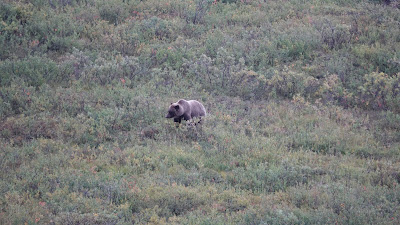Friday,
August 18th.
This morning I took the Wilderness Tundra safari the second time hoping to see more wildlife. We saw numerous caribou, two grizzlies and some more willow ptarmigan, but unfortunately no moose. Denali National Park and Preserve uses a bus system for tourists, much like Zion NP does. Private vehicles are not allowed to drive more than 13 miles into where the paved road ends, unless they have back country camping passes. Today I had a different driver who gave us additional information. He told us that the boreal or taiga forests that circle the globe at this latitude provide 1/3 of the world’s oxygen. The tree line here is only 2700’ as we are quite far north. 70% of moose don’t survive their first year which is why the females typically have twins. Black bears are smaller and live more in the forests as they are tree climbers and grizzly bears live more on the open tundra. The grizzlies here are smaller than the ones on the coast that have the rich fatty diet of salmon year-round. A caribou can lose about a pint of blood per day from mosquitoes in the spring which is why they run and try to stay on snow where it is colder. Caribou's antlers grow an inch per day and the antlers of a moose grow about one pound per day and can weigh eighty pounds! Caribou and moose shed their antlers in the fall and grow them again in the spring. These antlers are an excellent source of calcium for the small creatures of the park. When I got back, I just had time to have lunch with Julie and a couple of other people before boarding the coach for Fairbanks. It was a three-and-a-half-hour drive, but we stopped about halfway for a stop in a little, probably atypical central Alaskan town called Nenana. It had two or three beat up cafes, two lodgings, a grocery store, two small liquor stores, a souvenir shop, and a train station with a very shabby railway museum. If there was ever a place to miss the bus and get left behind, this was not it. While we were driving a moose ran across the highway. Our driver told us some very interesting things about living up here. There are few medical facilities, and most people have helicopter insurance so they can be flown out for help. If a moose becomes roadkill the state troopers call people who live in the area to come out and collect the meat. We arrived at our hotel about 5:30 and the first building I saw said ‘Alaska ammo and shooting range’. I decided to go to Creamer’s Field Migratory Waterfowl Refuge to see the thousands of sandhill cranes as part of the Crane Festival of Fairbanks. The birds use these fields as a resting place on their route from the tundra of the north to Florida and Mexico. Three of us went and we joined a walking informative tour. We were told that thousands of cranes use this stop off point. When we got there, we saw three cranes in the field and while we were getting organized, they flew off! Turns out the weather further north is still quite warm, and the birds are a week or two late. Thank you, climate change. As we walked around several flew over our heads and landed, as well as a flock of Canada geese. We found a couple of dozen more in the marsh as we walked. Back to the hotel by about nine. As a sidebar, Creamer’s used to be a dairy farm with 200 head of cattle that specialized in all dairy products and were known for their ice cream. Great name for a dairy farmer!













I'm impressed by all the detail you remember in your ever so informative posts, Joe. You are our very own David Attenborough.
ReplyDelete